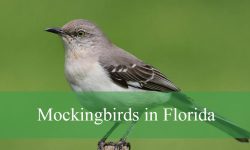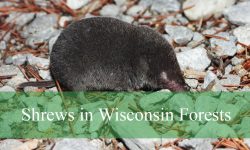Kentucky has many different birds of prey that make it a great place for birdwatchers and nature lovers. From the Red-tailed Hawk to the rare Northern Goshawk, these birds live in the state’s forests, fields, and wetlands all year round. You can see these strong hunters soaring in the sky or resting in trees.
Knowing how to identify birds of prey in Kentucky helps you enjoy watching them more. Each bird has special features like size, color, flying style, and calls that make it unique. This guide shows 25 birds of prey you can find in Kentucky, with pictures and simple tips to recognize them.
Seeing birds of prey in Kentucky is exciting and also important for nature. These birds help keep the environment healthy by hunting small animals and cleaning up dead animals. Learning about them helps us appreciate the amazing variety of birds living in Kentucky.
Common Birds of Prey Found in Kentucky
Red-tailed Hawk (Buteo jamaicensis)
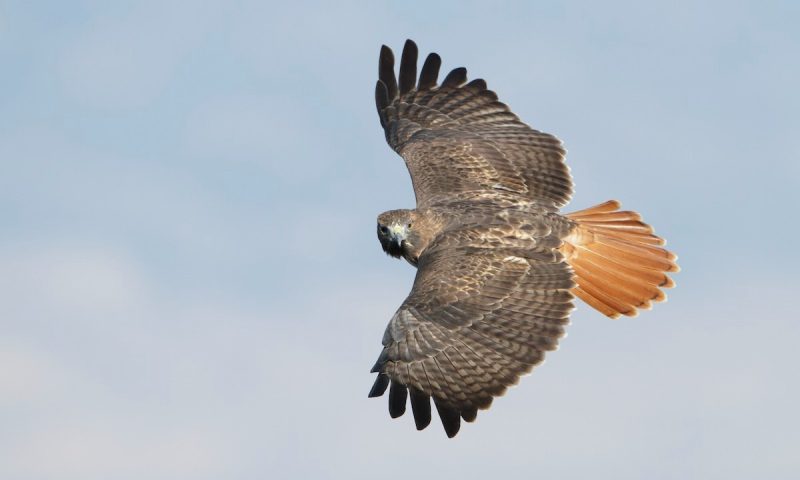
The Red-tailed Hawk is one of the most widespread and easily recognized raptors in North America. It features a rich brown back, pale underparts, and a distinctive reddish tail that gives the species its name. Adults typically measure between 19 to 25 inches in length, with wingspans ranging from 45 to 52 inches. Their broad, rounded wings and short, wide tails help them soar effortlessly across open landscapes.
This hawk is a skilled predator that hunts mainly during the day. It perches on poles, trees, or fenceposts to watch for prey, diving quickly when it spots rodents, rabbits, birds, or reptiles. It also uses its strong talons and keen eyesight to catch moving prey in grasslands and fields. Red-tailed Hawks are known for their loud, raspy scream, often heard during flight or when defending territory.
In Kentucky, the Red-tailed Hawk is a year-round resident, commonly found across the entire state. It prefers open habitats such as grasslands, agricultural areas, and forest edges. The bird’s adaptability to both rural and urban environments makes it one of the most commonly sighted raptors throughout the Bluegrass State.
Red-shouldered Hawk (Buteo lineatus)

The Red-shouldered Hawk is a medium-sized bird of prey known for its striking appearance. Adults have a reddish-brown chest, bold black-and-white bands on the tail and wings, and rust-colored shoulders, which are visible when perched or in flight. It typically measures 17 to 24 inches in length with a wingspan of about 37 to 43 inches.
This hawk primarily hunts in woodland areas, using a perch-and-pounce method. It feeds on small mammals, amphibians, reptiles, and occasionally birds. Its call is a loud, repeated “kee-aah,” which often echoes through its forested habitat. Red-shouldered Hawks are territorial and may return to the same nesting area year after year, especially near streams or swamps.
In Kentucky, they are permanent residents and are most commonly found in riparian woodlands and wet bottomland forests. They are especially abundant in moist environments where tall trees and water sources support both nesting and hunting needs.
Broad-winged Hawk (Buteo platypterus)

The Broad-winged Hawk is a compact raptor with short, broad wings and a square-shaped tail marked by bold black-and-white bands. Adults reach about 13 to 17 inches in length, with wingspans from 32 to 39 inches. When soaring, they display a characteristic pale underwing with a dark border, making them identifiable during migration.
This hawk feeds on small mammals, frogs, insects, and reptiles, hunting from a concealed perch within dense forests. It is particularly known for its spectacular fall migration, forming large groups called “kettles” that spiral on thermal currents. Broad-winged Hawks are relatively secretive during the breeding season, often nesting high in trees within thick woodlands.
In Kentucky, the Broad-winged Hawk is a summer visitor, breeding in the heavily forested eastern parts of the state. It arrives in spring and leaves by early fall, migrating to Central and South America for the winter. The bird is most often seen in remote wooded areas during the warmer months.
Rough-legged Hawk (Buteo lagopus)
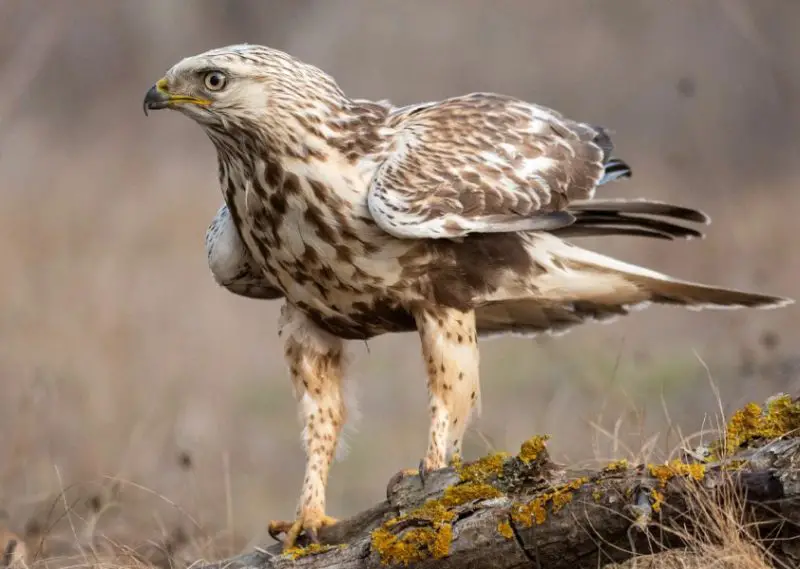
The Rough-legged Hawk is a large, long-winged raptor with feathered legs that help insulate it against cold climates. It has variable plumage but often shows a dark belly band and pale head, with a white tail marked by a dark terminal band. Adults measure between 18 to 20 inches in length with wingspans reaching up to 54 inches.
Unlike many hawks, the Rough-legged Hawk is more frequently seen hovering while hunting, using the wind to hold position as it scans for small mammals like voles and mice. It prefers open terrain and is most active during daylight hours in winter months. The hawk breeds in the Arctic tundra and only travels south during the cold season.
In Kentucky, it is a winter visitor, most commonly found in the northern and central regions of the state. It favors open grasslands, fields, and reclaimed mining lands, where it can spot prey with ease. Its presence marks the arrival of colder weather and adds seasonal variety to Kentucky’s raptor population.
Northern Harrier (Circus hudsonius)
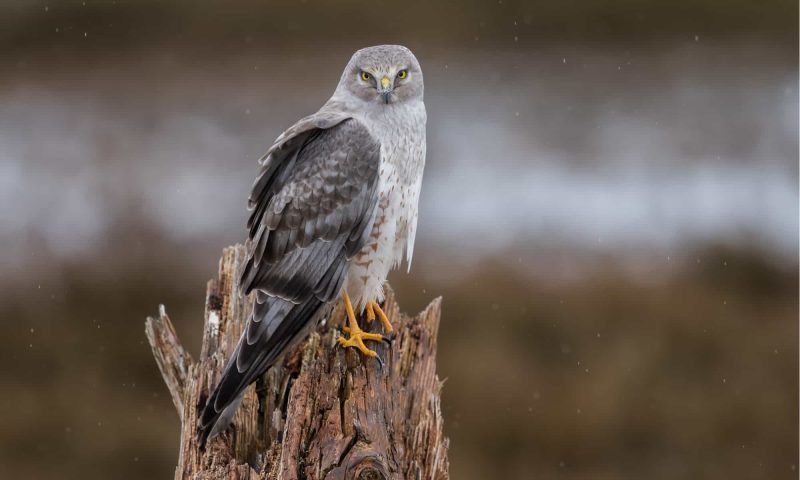
The Northern Harrier is a slender, medium-sized raptor easily recognized by its owl-like facial disk and long, narrow wings and tail. Adult males are gray above and white below, while females and juveniles are brown with streaked undersides. They typically measure between 18 to 20 inches in length, with wingspans ranging from 40 to 46 inches. Their low, gliding flight just above grass or marsh makes them easy to spot.
Northern Harriers are unique among hawks in their hunting style, often seen flying low over open fields and wetlands while listening and watching for small mammals and birds. Their facial disk helps them detect sound, similar to owls. They feed mostly on voles, mice, and small birds, and often nest on the ground in tall grass or marsh vegetation.
In Kentucky, Northern Harriers are present year-round but are most commonly seen in winter. They frequent open habitats such as grasslands, marshes, and wetlands throughout the state. These birds are especially noticeable in the colder months when they gather in suitable roosting areas in groups.
Cooper’s Hawk (Accipiter cooperii)
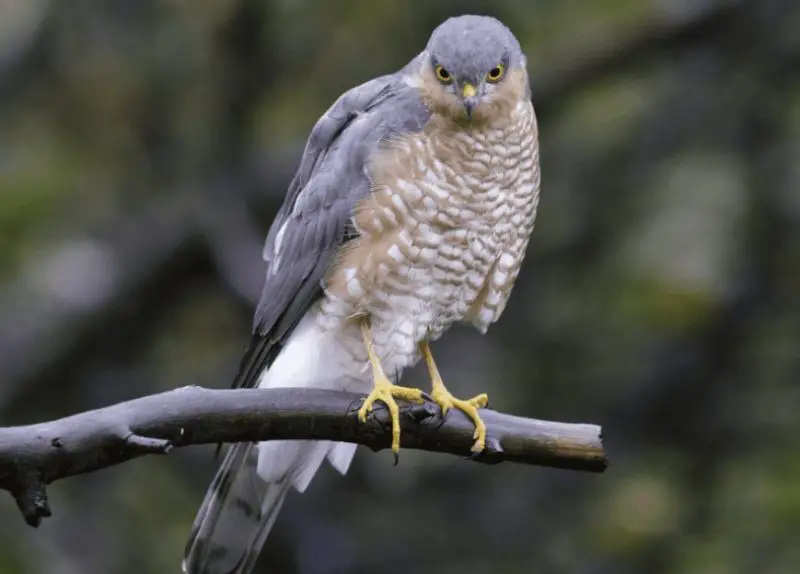
The Cooper’s Hawk is a medium-sized bird of prey known for its sleek build and agility. It has broad, rounded wings and a long tail with dark bands and a rounded tip. Adults have a blue-gray back, reddish barring on the chest, and a dark cap. They measure about 14 to 20 inches long, with a wingspan between 24 to 35 inches.
This hawk is a fast and agile flier, adapted for pursuing birds through dense tree cover. It preys mainly on small to medium-sized birds, such as doves and songbirds, often ambushing them in wooded neighborhoods or forest edges. Cooper’s Hawks are also known to visit backyard feeders, not for seed but to hunt birds attracted to the area.
In Kentucky, Cooper’s Hawks are permanent residents and are commonly seen in wooded suburbs, parks, and secondary forests. Their adaptability to urban and semi-urban environments makes them one of the more frequently observed hawks in residential areas across the state.
Sharp-shinned Hawk (Accipiter striatus)
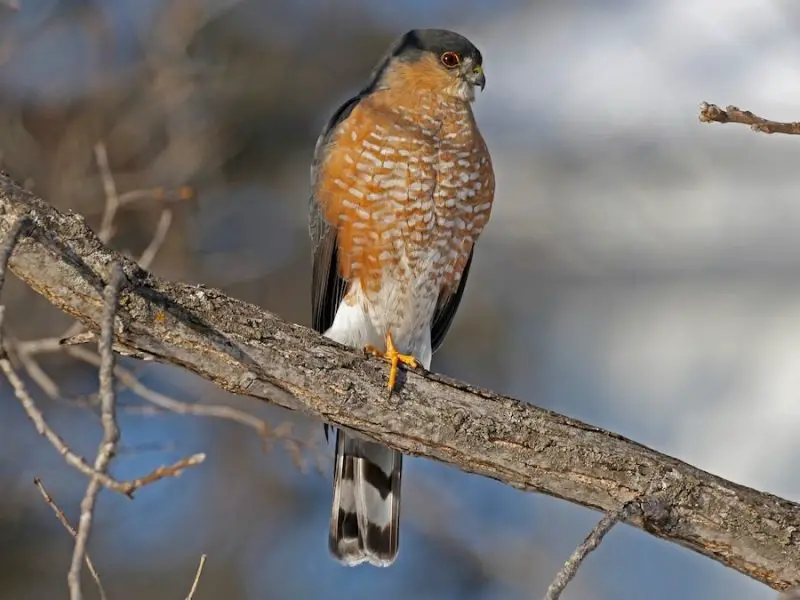
The Sharp-shinned Hawk is the smallest hawk in North America, with short, rounded wings and a long, narrow tail with a squared-off tip. Adults have a blue-gray back and reddish-barred chest, while juveniles are brown above with streaked underparts. They typically measure 9 to 13 inches in length, with a wingspan of 16 to 22 inches.
This hawk is a swift and secretive forest hunter, preying primarily on small songbirds. It often ambushes its prey in dense woods or near bird feeders, darting out quickly from cover. Its flight is characterized by several rapid wingbeats followed by short glides, allowing it to maneuver easily through tight spaces.
In Kentucky, the Sharp-shinned Hawk is a migratory species, present mainly during the winter months. It is found in wooded areas and residential neighborhoods with tree cover. Though less common than the Cooper’s Hawk, it plays a similar role in the ecosystem during its time in the state.
Northern Goshawk (Accipiter gentilis)
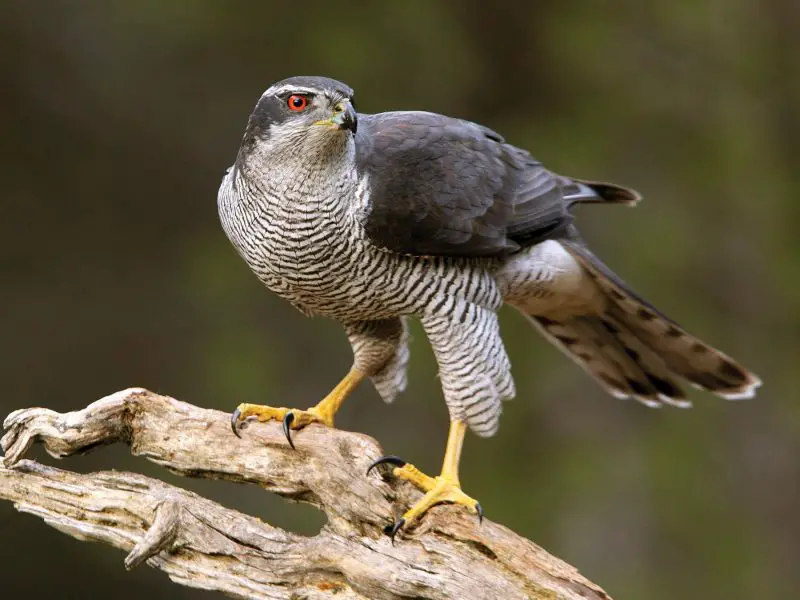
The Northern Goshawk is a large and powerful accipiter, rare in Kentucky. It has a broad chest, long tail, and strong wings. Adults are slate gray above with fine barring below and a bold white eyebrow stripe. They measure 20 to 26 inches in length with wingspans from 40 to 46 inches, making them the largest of the North American accipiters.
Goshawks are fierce and elusive predators that hunt birds and mammals in dense forests. They are known for their speed and determination, often chasing prey through heavy woods. Their diet includes squirrels, rabbits, grouse, and other medium-sized animals. These hawks nest in large trees in remote, forested habitats.
In Kentucky, Northern Goshawks are extremely rare and are typically only seen during winter in the deep forests of the eastern part of the state. Sightings are uncommon and often excite local birders due to the bird’s scarcity and elusive behavior.
Bald Eagle (Haliaeetus leucocephalus)
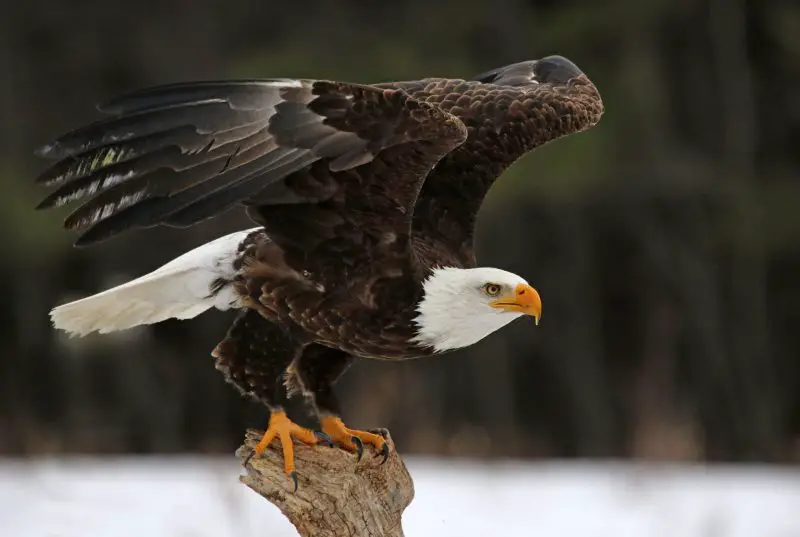
The Bald Eagle is a large and unmistakable raptor, best known for its white head and tail contrasting with a dark brown body. Juveniles are brown overall with mottled white patches and take up to five years to acquire adult plumage. They range from 28 to 40 inches in length with wingspans of 6 to 7.5 feet, making them one of the largest birds in North America.
These eagles primarily feed on fish, which they snatch from water surfaces with powerful talons. They also eat waterfowl, carrion, and small mammals. Bald Eagles often perch high in trees near lakes and rivers, and they build massive stick nests that are reused and added to year after year. Their calls are surprisingly weak, consisting of high-pitched whistles.
In Kentucky, Bald Eagles are seen year-round but are most numerous in winter when northern populations migrate south. They are especially common near large lakes, rivers, and reservoirs, particularly in western parts of the state such as around Kentucky Lake and the Land Between the Lakes area.
Golden Eagle (Aquila chrysaetos)
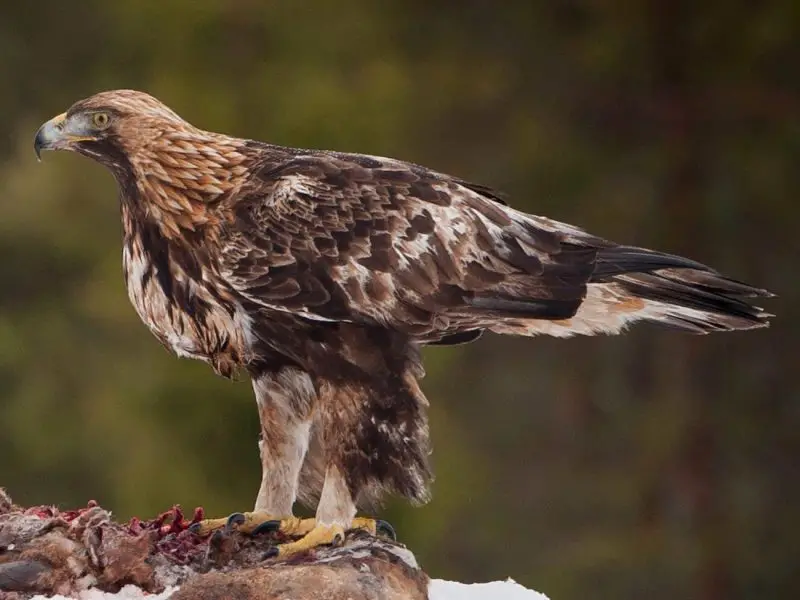
The Golden Eagle is a majestic raptor with a dark brown body and golden feathers on the back of its head and neck. It is slightly smaller than the Bald Eagle but more agile and powerful in flight. Adults measure 26 to 40 inches long with wingspans of 6 to 7.5 feet. Immature birds have white patches at the base of the tail and wings.
Golden Eagles hunt a wide range of prey, including rabbits, squirrels, and ground-dwelling birds. They use soaring flight over rugged terrain to spot and pursue their prey. These eagles prefer open or semi-open areas and avoid human development, often nesting on cliffs or in tall trees in remote locations.
In Kentucky, Golden Eagles are rare winter visitors, primarily found in the forested hills and mountains of the eastern region. Their preference for secluded, rugged terrain makes them difficult to spot, but they are occasionally seen by birders and researchers during specialized surveys in winter months.
Osprey (Pandion haliaetus)
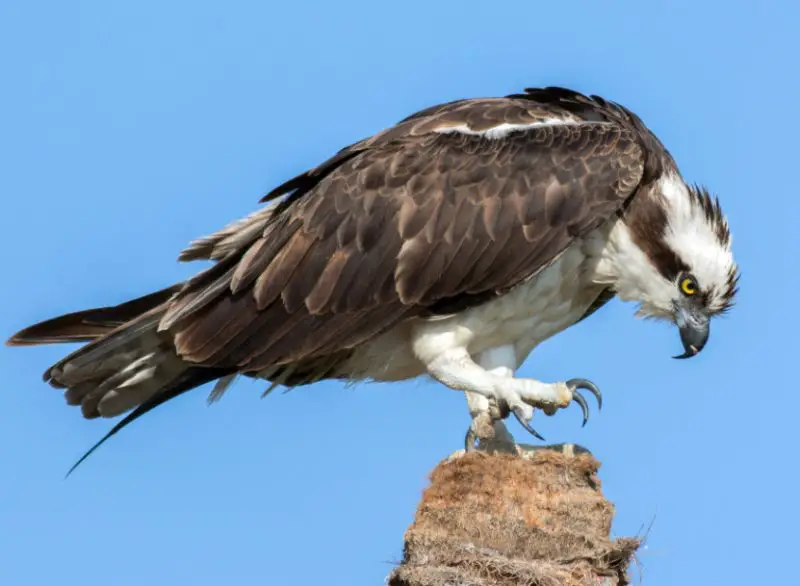
The Osprey is a large, fish-eating raptor known for its striking white underside, dark eye stripe, and long, narrow wings with a distinctive kink forming an “M” shape in flight. Adults typically measure 21 to 23 inches in length and have wingspans between 5 to 6 feet. Their dark brown upperparts and contrasting white head and belly make them easy to identify near water.
Ospreys are specialized hunters that feed almost exclusively on live fish. They hover above water before diving feet-first to snatch their prey with sharp talons. Their feet are uniquely adapted for grasping slippery fish, with reversible outer toes and barbed pads. Ospreys build large stick nests near water, often on manmade platforms or tall structures.
In Kentucky, Ospreys are migratory birds seen primarily during spring and fall, with a few pairs nesting near large lakes, dams, and along the Ohio River. Their presence increases during migration, especially around open bodies of water where fish are abundant.
American Kestrel (Falco sparverius)
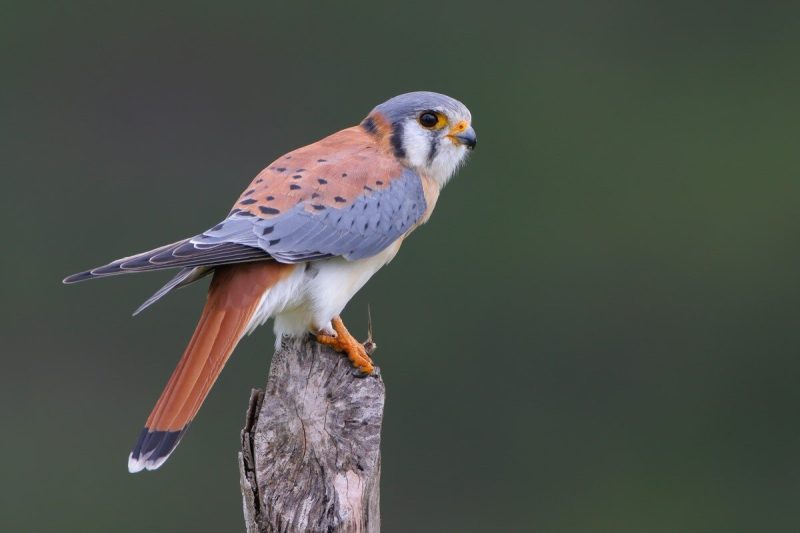
The American Kestrel is North America’s smallest falcon, recognized by its colorful plumage and compact size. Males have a slate-blue head and wings with rusty backs and spotted underparts, while females are mostly rufous with black barring. These falcons measure about 8 to 12 inches long with wingspans between 20 to 24 inches.
This falcon hunts by hovering in mid-air or perching on wires and posts, scanning for insects, small mammals, and birds. It uses its sharp vision and quick dives to catch prey on the ground. Kestrels are cavity nesters and often use tree holes, buildings, or nest boxes to raise their young.
In Kentucky, American Kestrels are year-round residents and are commonly seen in open areas such as farmland, grasslands, and along highways. They are often spotted on telephone wires or near power substations, especially where open space and hunting grounds are available.
Merlin (Falco columbarius)

The Merlin is a small but powerful falcon, built for speed and pursuit. It has a stocky body, pointed wings, and a medium-length tail. Plumage varies, but most Merlins are dark gray or brown above with streaked underparts. They measure 9 to 12 inches long and have wingspans of about 20 to 26 inches.
Merlins are fierce predators that specialize in catching small birds mid-air. They often hunt in open areas or near towns, using fast, low flights to surprise prey. Unlike kestrels, they do not hover and are usually more elusive. Their aggressive behavior and quick flight make them exciting to observe during migration.
In Kentucky, Merlins are primarily seen in winter or during migration. They are found in urban areas, open fields, and grasslands across the state. Though less common than other falcons, they make occasional appearances, especially during their seasonal movements.
Peregrine Falcon (Falco peregrinus)
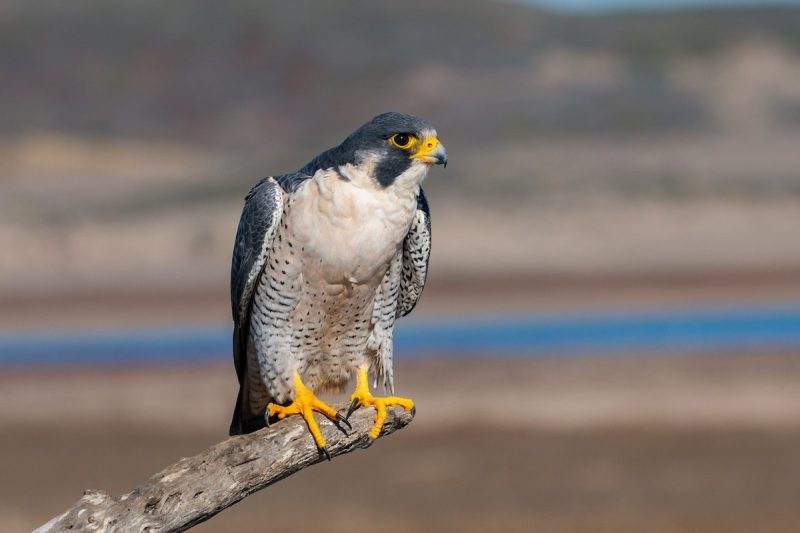
The Peregrine Falcon is a powerful and fast-flying raptor, famous for being the fastest bird in the world. Adults are blue-gray above with a barred underside and a black head with a bold mustache mark. They measure about 14 to 19 inches in length with wingspans ranging from 37 to 43 inches.
Peregrines specialize in aerial hunting, often striking birds mid-flight with incredible speed and precision. Their diet includes pigeons, doves, shorebirds, and waterfowl. These falcons nest on cliff ledges and, more recently, on tall urban buildings and bridges, adapting well to city environments.
In Kentucky, Peregrine Falcons are primarily migratory, though some nest in cities like Louisville and other areas along the Ohio River. They are most commonly observed during migration or winter, especially around large cities or river cliffs where prey is plentiful.
Mississippi Kite (Ictinia mississippiensis)
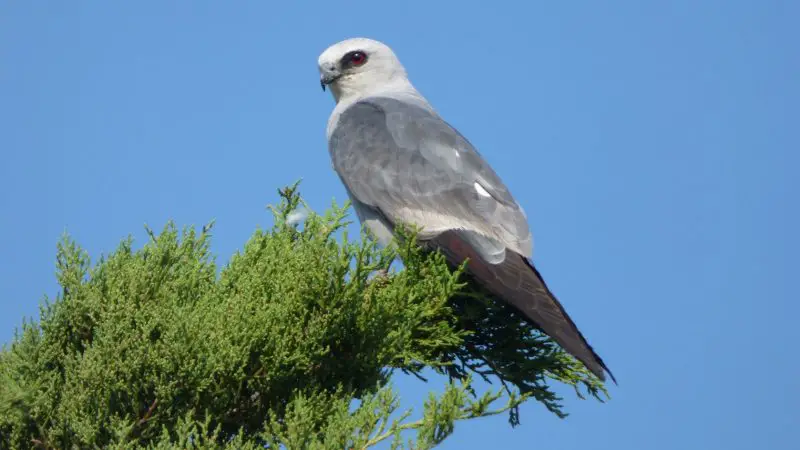
The Mississippi Kite is a slender and graceful raptor with a pale gray body, dark wingtips, and a long, pointed tail. Adults measure about 12 to 15 inches in length with wingspans of 36 to 42 inches. Their elegant flight and forked tail give them a streamlined appearance, often compared to that of swallows.
These kites feed mostly on flying insects such as cicadas, dragonflies, and beetles, which they snatch in mid-air. They are highly social and often seen soaring in groups or roosting communally. Mississippi Kites typically nest in tall trees near rivers, using twigs and leaves to build their nests.
In Kentucky, Mississippi Kites are summer visitors, arriving in late spring and staying through the breeding season. They are most commonly found in the southern and western parts of the state, particularly in riverine forests and open woodlands near water.
Swallow-tailed Kite (Elanoides forficatus)

The Swallow-tailed Kite is a striking and elegant raptor, easily recognized by its contrasting black-and-white plumage and long, deeply forked tail. It measures about 19 to 25 inches in length, with an impressive wingspan of up to 4.5 feet. Its graceful flight and aerodynamic build allow it to glide effortlessly while twisting its tail to steer with precision.
This kite feeds mainly on flying insects, small reptiles, amphibians, and occasionally nestling birds. It often plucks prey from treetops or mid-air without landing. Known for its acrobatic maneuvers, it rarely flaps its wings for long, instead soaring and gliding through open skies above forests and wetlands. It builds nests in tall trees, often in remote or undisturbed areas.
In Kentucky, the Swallow-tailed Kite is a very rare migrant, usually seen only in the southern part of the state during spring or late summer. These sightings are typically brief as the birds pass through open woodlands and forest edges on their way to and from breeding grounds farther south.
Barn Owl (Tyto alba)
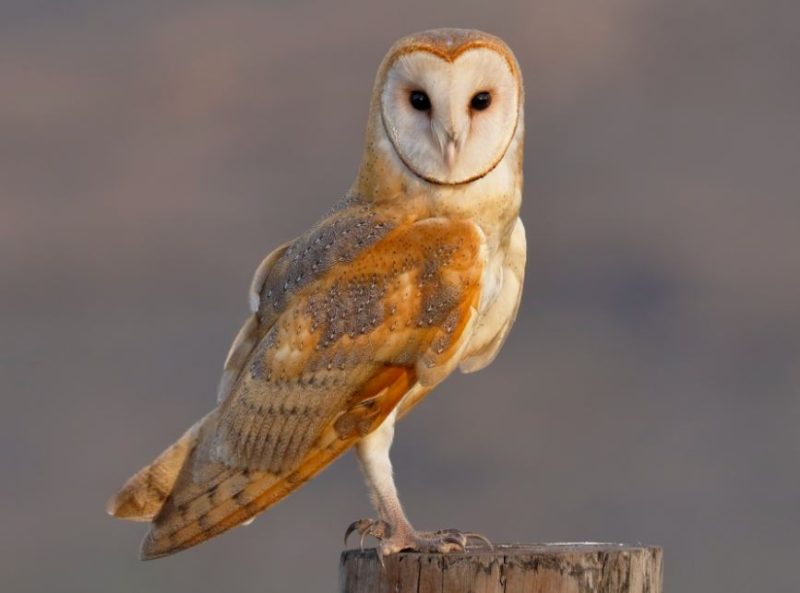
The Barn Owl is a pale, medium-sized owl with a distinctive heart-shaped face and dark eyes. Its plumage is a mix of white, golden-buff, and gray, with a ghostly appearance in low light. Measuring about 12 to 16 inches long with wingspans of 39 to 49 inches, it is built for silent flight and nighttime hunting.
This owl primarily feeds on small mammals, especially voles, mice, and rats. It hunts by flying low over open fields and meadows, using its exceptional hearing to detect prey in total darkness. Unlike most owls, the Barn Owl does not hoot but instead produces eerie screeches and hissing sounds. It typically nests in barns, silos, abandoned buildings, or hollow trees.
In Kentucky, Barn Owls are year-round residents, especially in rural areas. They are commonly found in open grasslands, farmlands, and old structures where prey is abundant and nest sites are available. Their presence is often detected more by sound than sight due to their nocturnal and elusive nature.
Eastern Screech-Owl (Megascops asio)
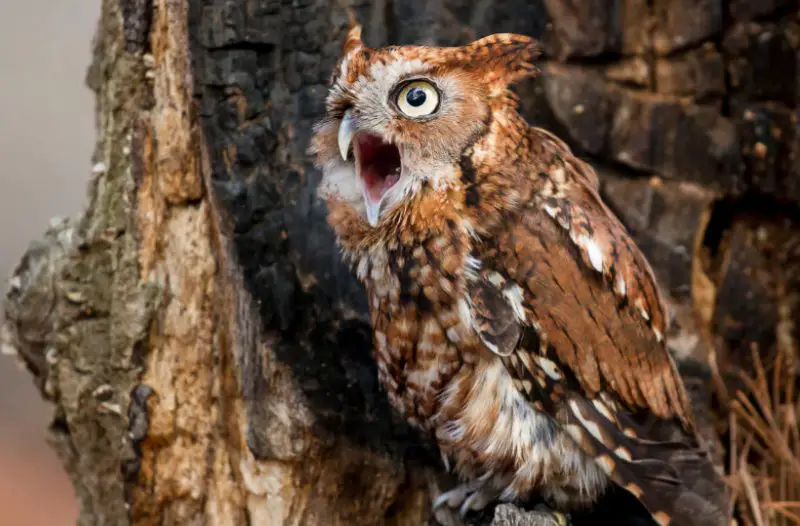
The Eastern Screech-Owl is a small, stocky owl with prominent ear tufts and camouflage plumage that comes in gray or reddish-brown morphs. It typically measures 6 to 10 inches in length with a wingspan of 18 to 24 inches. Despite its small size, it has a fierce personality and blends well with tree bark.
This owl is an opportunistic predator, feeding on insects, small rodents, birds, and even amphibians. It hunts from perches at night, swooping silently on prey below. Its call is a haunting trill or whinny, often heard more than the bird is seen. Eastern Screech-Owls nest in natural tree cavities or nest boxes and are surprisingly tolerant of human presence.
In Kentucky, this species is found year-round throughout the state in wooded areas, orchards, parks, and suburban yards. It thrives in a wide range of habitats, provided there are trees for cover and nesting. Despite its secretive habits, it is one of the most common owls in the region.
Great Horned Owl (Bubo virginianus)
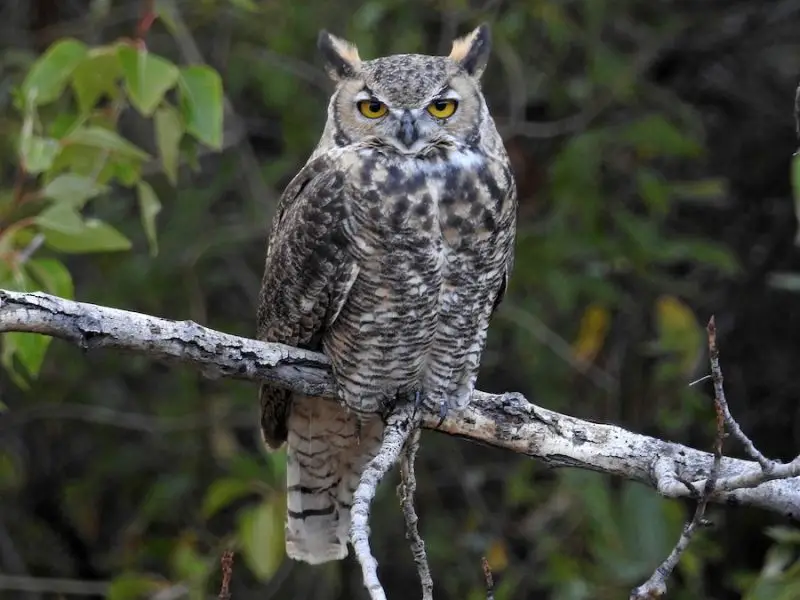
The Great Horned Owl is one of the largest and most powerful owls in North America. It is characterized by its large size, prominent ear tufts, yellow eyes, and mottled brown and gray feathers. Adults measure 18 to 25 inches long, with wingspans between 40 to 57 inches. Its deep hooting call is iconic and carries far through the night.
This owl is a top nocturnal predator that preys on a wide variety of animals, including rabbits, skunks, birds, and even other owls. It uses its strong talons and silent flight to ambush prey from above. Great Horned Owls are early nesters, often taking over old nests built by hawks or other birds.
In Kentucky, the Great Horned Owl is a year-round resident and is found in nearly every type of habitat, from forests and farmlands to urban parks and desert edges. Its adaptability and broad diet make it one of the most widespread owls in the state.
Barred Owl (Strix varia)
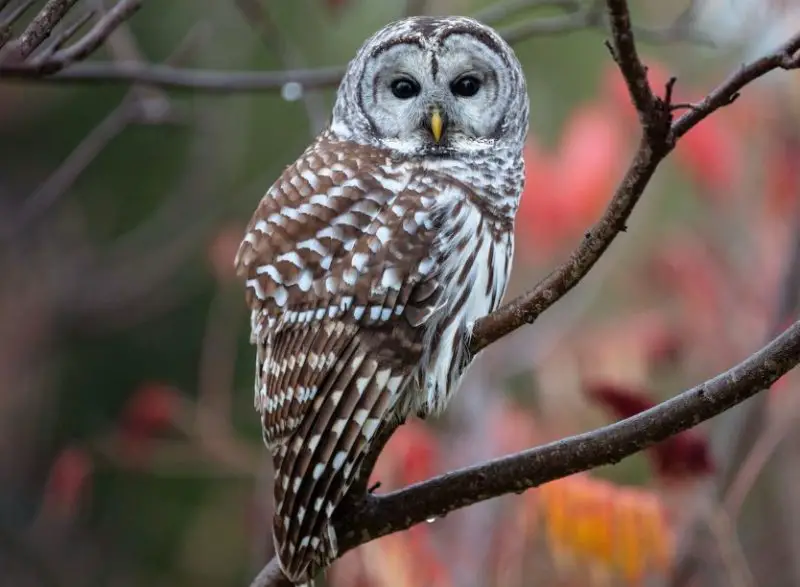
The Barred Owl is a large, round-headed owl known for its dark eyes and distinctive hooting call that sounds like “Who cooks for you? Who cooks for you all?” It has mottled brown and white plumage with horizontal barring on the chest and vertical streaks on the belly. Adults measure about 17 to 20 inches in length with wingspans of 39 to 44 inches.
This owl hunts mostly at night but may also be active during the day, especially in overcast or rainy weather. It preys on small mammals, birds, amphibians, and reptiles, often waiting silently on a perch before swooping down. Barred Owls nest in tree cavities, abandoned hawk nests, or artificial boxes.
In Kentucky, Barred Owls are permanent residents, thriving in moist woodlands near rivers, swamps, and wetlands. They are most common in forested habitats with abundant cover and water, especially in the eastern and central parts of the state. Their distinctive call is often heard in the evening or early morning hours.
Long-eared Owl (Asio otus)
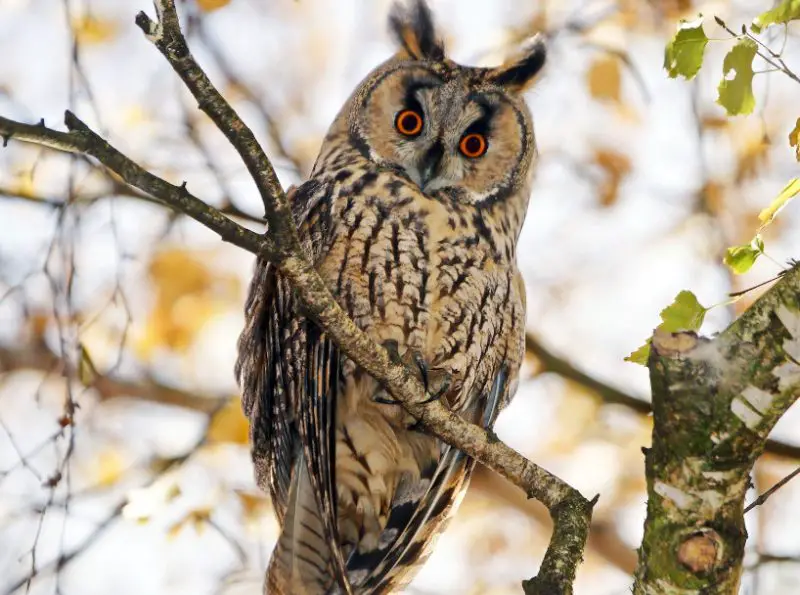
The Long-eared Owl is a slender, medium-sized owl known for its tall ear tufts and mottled brown and buff plumage that blends perfectly with tree bark. It measures around 13 to 16 inches in length and has a wingspan of about 35 to 40 inches. Its orange facial disks and piercing yellow eyes give it a striking appearance, especially when seen at close range.
This owl is a nocturnal hunter that primarily feeds on small mammals such as voles and mice. It hunts by flying low over open fields at night, using its exceptional hearing to locate prey. During the day, it roosts in dense evergreen or deciduous thickets, often in groups, staying extremely well hidden. Its quiet and elusive nature makes it one of the harder owls to observe.
In Kentucky, Long-eared Owls are winter visitors and are most likely to be found in woodlands bordering open grasslands. They are rarely seen due to their secretive daytime roosting habits, but they occasionally turn up during careful winter surveys or in known roosting sites in the central and western parts of the state.
Short-eared Owl (Asio flammeus)
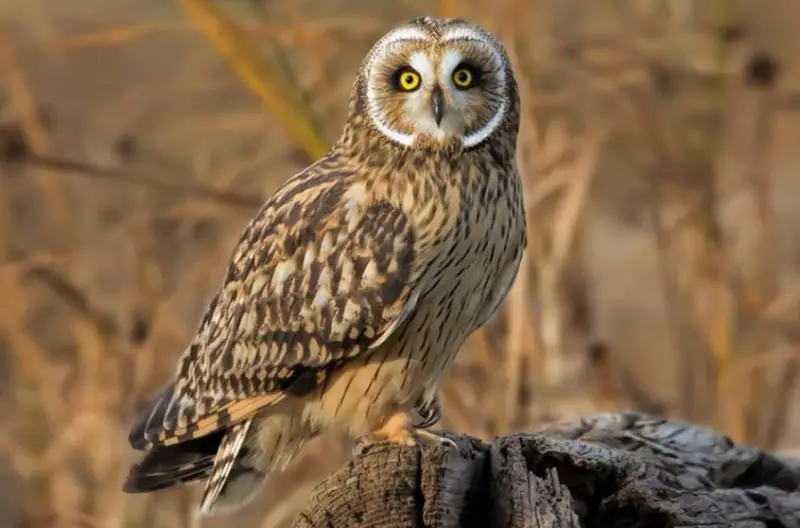
The Short-eared Owl is a ground-nesting owl with a rounded head, small barely visible ear tufts, and large yellow eyes set in pale facial disks. It measures about 13 to 17 inches in length and has a wingspan of 33 to 40 inches. When in flight, it shows dark wrist patches on its wings and a buoyant, moth-like flight style.
Unlike many owls, the Short-eared Owl is often active during the day, especially at dawn and dusk. It hunts by gliding low over grasslands and open fields, searching for voles, mice, and other small mammals. It nests and roosts on the ground in tall grasses or weedy fields and is known for its erratic flight and barking calls.
In Kentucky, Short-eared Owls are winter residents, especially in open areas such as abandoned fields, native prairies, and reclaimed mine lands. They are most often seen in the central and western parts of the state and are more likely to be observed flying during the daylight than other owl species.
Northern Saw-whet Owl (Aegolius acadicus)
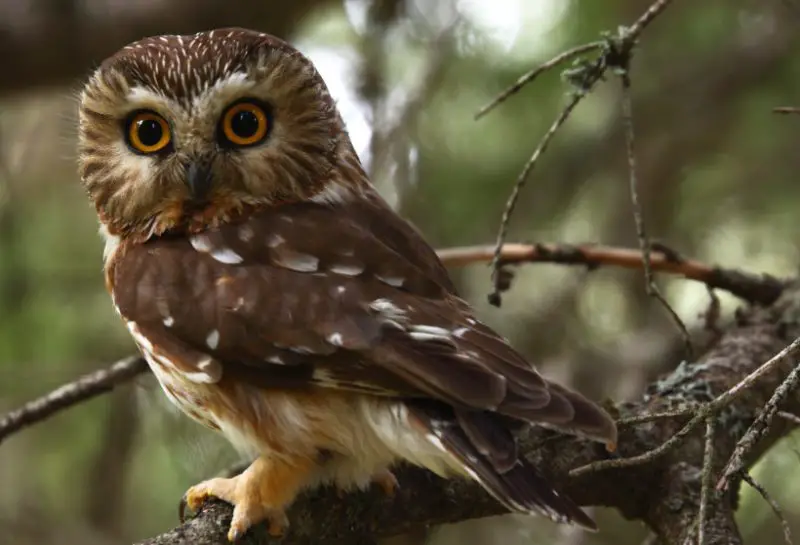
The Northern Saw-whet Owl is a tiny, round-headed owl with no ear tufts, and it has large yellow eyes and a white facial disk that gives it a doll-like appearance. It ranges from 7 to 8 inches in length and has a wingspan of 16 to 19 inches. Its soft brown and white plumage helps it stay hidden in dense foliage.
This owl feeds mostly on small rodents and birds, hunting silently at night from low perches. It is named for its call, which resembles the sound of a saw being sharpened. It is a cavity nester and uses old woodpecker holes or nest boxes in heavily wooded habitats. Despite its small size, it is a capable and efficient predator.
In Kentucky, the Northern Saw-whet Owl is a rare winter visitor, usually found in dense forests, especially coniferous or mixed woodlands. Most records come from the eastern part of the state, and sightings are generally limited to bird banding efforts or lucky encounters during migration periods.
Snowy Owl (Bubo scandiacus)
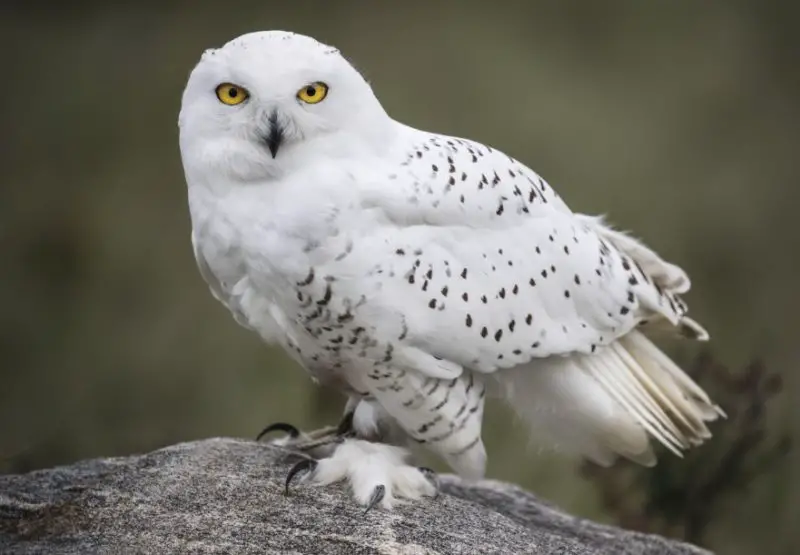
The Snowy Owl is a large, powerful owl with bright white plumage marked by varying degrees of dark spots or barring, more prominent in females and juveniles. Adults measure 20 to 28 inches long with wingspans from 49 to 59 inches. Their yellow eyes and rounded heads give them a striking, ghostly appearance.
These owls primarily hunt lemmings and other small mammals in their Arctic breeding grounds but will take a wide variety of prey during irruption years when they move south. They are diurnal and often hunt during the day by watching from elevated perches. Snowy Owls prefer open, treeless habitats that resemble tundra.
In Kentucky, Snowy Owls are extremely rare and typically only appear during irruption years, when food shortages in the Arctic push them far south of their normal range. When they do arrive, they are most often found in northern Kentucky in open spaces like agricultural fields, airports, and lakefronts during winter.
Turkey Vulture (Cathartes aura)

The Turkey Vulture is a large, dark bird with a featherless red head and long, broad wings held in a distinctive “V” shape while soaring. It measures about 25 to 32 inches in length and has a wingspan of up to 6 feet. Its flight is buoyant and wobbling, often using thermals to stay aloft with minimal effort.
Unlike true raptors, Turkey Vultures feed exclusively on carrion, using their excellent sense of smell to locate dead animals. They play an important ecological role by cleaning up carcasses. Although they do not hunt live prey, their strong beaks and stomach acids allow them to safely consume decaying meat. They are mostly silent, lacking a syrinx, and communicate through hisses and grunts.
In Kentucky, Turkey Vultures are found statewide throughout the year, with numbers peaking in spring and fall during migration. They are common in rural areas, roadways, forests, and even urban outskirts, often roosting in large communal groups on trees, buildings, or cliffs.
FAQ about Birds of Prey in Kentucky
What types of birds of prey can be found in Kentucky?
Kentucky hosts a diverse range of birds of prey, including hawks like the Red-tailed Hawk and Broad-winged Hawk, falcons such as the American Kestrel and Peregrine Falcon, owls like the Great Horned Owl and Barred Owl, and scavengers like the Turkey Vulture. Some species are year-round residents, while others are seasonal visitors or migrants.
When is the best time to see birds of prey in Kentucky?
Birds of prey can be observed year-round in Kentucky, but specific species have peak seasons. For example, Rough-legged Hawks and Short-eared Owls are more common in winter, while Broad-winged Hawks migrate through in spring and fall. Summer is ideal for spotting species like the Mississippi Kite and Broad-winged Hawk in forested areas.
Where are the best habitats to find birds of prey in Kentucky?
Birds of prey inhabit a variety of environments in Kentucky. Open fields, grasslands, and forest edges are great for hawks like the Red-tailed Hawk. Wetlands and riparian forests support Red-shouldered Hawks and Barred Owls. Large lakes and rivers attract Bald Eagles and Ospreys, while open fields and abandoned farmland are frequented by Short-eared Owls and American Kestrels.
How can I identify different birds of prey in Kentucky?
Identification relies on size, shape, plumage, flight pattern, and habitat. For instance, Red-tailed Hawks have a distinctive reddish tail and broad wings, while American Kestrels are small with colorful plumage. Owls such as the Great Horned Owl have prominent ear tufts and deep hoots. Learning their calls and observing flight behaviors can also help distinguish species.
Are any birds of prey in Kentucky endangered or protected?
Many birds of prey in Kentucky are protected under the Migratory Bird Treaty Act and other conservation laws. While some species, like the Peregrine Falcon, have made strong recoveries due to conservation efforts, others may still face threats from habitat loss and environmental contaminants. Observing birds responsibly and supporting habitat protection helps ensure their continued presence.
Can birds of prey be found in urban areas of Kentucky?
Yes, some birds of prey adapt well to urban and suburban environments. Cooper’s Hawks and Peregrine Falcons often hunt in cities, nesting on tall buildings or bridges. American Kestrels may hunt along city edges, and Turkey Vultures are frequently seen soaring over urban landscapes. Green spaces and parks provide important habitat within these areas.
What do birds of prey in Kentucky typically eat?
Diet varies by species but generally includes small mammals, birds, reptiles, and insects. Hawks and falcons often hunt rodents, rabbits, and smaller birds. Owls feed on rodents, insects, and occasionally small birds. Scavengers like Turkey Vultures consume carrion. Aquatic hunters like Ospreys primarily eat fish.
How can I help support birds of prey conservation in Kentucky?
You can support birds of prey by preserving and restoring natural habitats, avoiding the use of harmful pesticides, and participating in or supporting local conservation organizations. Providing nest boxes for species like American Kestrels and reducing hazards such as window collisions also helps. Reporting sightings to local birding groups can aid monitoring efforts.
Are there any special regulations for observing or handling birds of prey in Kentucky?
Yes, most birds of prey are protected by law, and it is illegal to harm, capture, or disturb them without proper permits. Observers should maintain a respectful distance, avoid disrupting nests or roosts, and follow guidelines set by wildlife agencies. For education or rehabilitation purposes, special licenses are required. Always check local regulations before interacting with wildlife.

